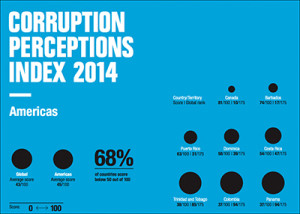Transparency International’s 2014 Corruption Index Reveals More Needs to Be Done to Fight Illegal Activities
By Jeff Pizzino, APR, Corporate Communications –

Transparency International’s just-released corruption report shows many Latin America governments are mired in illegal activities like bribes, fraud and theft.
Transparency International, a non-profit watchdog group dedicated to uncovering corruption and promoting government transparency, released the 20th edition of its annual corruption perceptions index on Dec. 3. More than two-thirds of the 175 countries reviewed received a score of less than 50 on a scale of 0-100. While no country is completely corruption-free, the level varies considerably between countries. Denmark, with a score of 92, is the least corrupt country. However, Somalia and North Korea were tied with a score of 8 — making them the most world’s most corrupt countries. In the Americas, Canada, Barbados, the U.S., Chile and Uruguay were the least corrupt, while Venezuela, Haiti, Paraguay, Nicaragua and Honduras were the most corrupt.
The report is based on the opinions of experts about individual countries’ private sector corruption.
“The 2014 Corruption Perceptions Index shows that economic growth is undermined and efforts to stop corruption fade when leaders and high level officials abuse power to appropriate public funds for personal gain,” said José Ugaz, the chair of Transparency International.
Latin America Corruption Levels
The countries of Latin America reflect a long-term trend of placement in the “red zone” — a score of below 50 — indicating corruption is at its most pervasive among government, businesses and the population at large. For example, the report indicates that in Mexico, company employees commit 47 percent of all theft of goods and money.
To address these corruption concerns, governments and business now have a new lie detection technology at their disposal — EyeDetect, Converus’ ocular-based deception solution.
Using EyeDetect, businesses and government bodies can create a culture of honesty and integrity by performing pre-employment screening and periodic employee evaluations to monitor for involvement in crimes, stealing, bribes, drug use, money laundering, and identity theft. When used in conjunction with a polygraph, organizations can achieve a deception detection accuracy rate of more than 98 percent.
By employing this new technology, countries in the red zone will be able to change their color and move their countries toward a more transparent and prosperous future.

